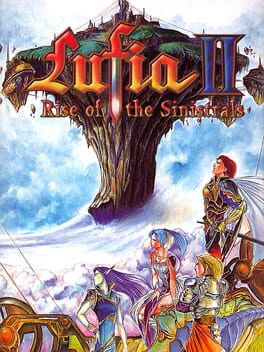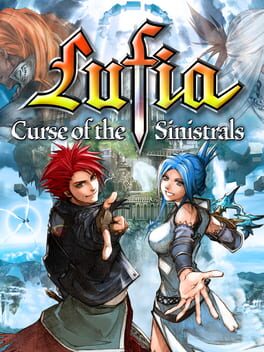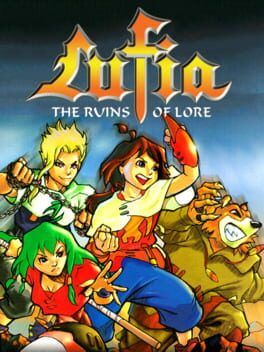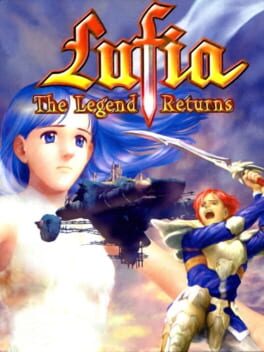

Lufia II: Rise of the Sinistrals serves as a prequel to Lufia & the Fortress of Doom, unfolding its events ninety-nine years before. The narrative delves into the origins of the series' antagonists, the Sinistrals, a group of super-humans. Players take on the role of the ancestor of Maxim, the protagonist from the first game, as he embarks on a quest after encountering Iris, a mysterious woman. Maxim seeks other heroes to join forces in preventing the Sinistrals from wreaking havoc and destroying the world. Like its predecessor, Rise of the Sinistrals follows the Japanese-style turn-based RPG format with an infusion of puzzle elements. The game incorporates intricate puzzles into its dungeon designs, requiring players to use various items and accessories for solving. Additionally, it introduces the "Capsule Monsters" system, allowing summoned monsters to participate in battles. These creatures evolve through the consumption of weapons, armour, or special fruits. Unlike the first game, dungeons in Rise of the Sinistrals lack random battles, with enemies visibly moving on-screen.
Also in series
Reviews View More
Lufia II, its prequel, feels like it understood in more ways than one how monotonous the first game was. It feels like every improvements and changes made to this game was an answer to this, and I can't help but compare them.
A lot more dialogues, better characterization, dungeons with actual level design obviously borrowed from ALTTP and no more random encounters inside them, etc, etc.. This game screams "We don't want you, the player, to be bored".
And for the most part, it works. As I said, the dungeons are the obvious exemples of these changes. You have access to tools in order to progress in rooms filled with puzzles in contrast to the aimless roaming in Lufia 1, meaning surviving isn't the only goal now, you actually get rewarded for thinking hard enough, with better equipments or even Capsule Monsters, which are additionnal party members you can't control but can come handy. Thanksfully, no random encounters mean you can move around and solve these riddles without too much worries, a change that may seems obvious today but clearly shows hindsight for the time it was released. You still alternate between towns and dungeons to move the story forward, but now it feels less like a chore and more like " I'm looking forward to the next dungeon " for most of the time. In term of design, some of these puzzles can be tedious, but that's not the majority, especially considering how Lufia II is the first JRPG to my knowledge with dungeons like this.
Lufia I and II share the same structure too, but there's much more dialogues now, stuff I would consider boring fetch-quests in Lufia 1 are now funny little antics making me grow attached to the characters (it's always funny to see Guy and Dekar interact), balancing the more serious and touching bits of the story. Not to mention if you played Lufia 1, you know how the story will end, it's interesting to see how the game try to bait us with characters that come and go in your party, before the final confrontation against the Sinistrals mirroring the brilliant intro of Lufia 1.
With all that being said, man am I glad to have played the first Lufia before this one. In its quest to be a more pleasant experience than its predecessor, I can't help but think some things were lost. Take the battle system, I actually really liked how you had to think before acting in Lufia I because of the game choosing for you which ennemy you will hit when targeting a specific group, combined with the game not changing target when hitting a dead ennemy. Don't get me wrong, Fortress of Doom was a tedious grindfest 50% of the time, but when that was done, random encounters were actually dangerous and fun. In Lufia II, the battle system was streamlined to something more traditionnal, you can target ennemies precisely with no downsides whatsoever like most JRPGs at the time, and while the IP system giving special abilities depending on your equipment is an interesting idea, in practice, battles are far easier and somewhat more boring than in the first game. An other thing to consider is that the progression is way more linear than Lufia 1, you simply won't get lost most of the time. It's not like the first game wasn't linear too, but you could visit 2 or 3 towns simultaneously in some parts, which is just not the case in Rise of the Sinistrals. Personally, I like getting lost in JRPG, it gives a slower pace and feels like time is actually passing, making some relationship and events more credibles. Everything in Lufia 2 might happens a bit too quickly for my taste, such as how Selan fall in love with Maxim.
I don't want to spend too much time comparing the two games, but I wanted to give some response to the " skip Lufia 1 and play Rise of the Sinistrals ". In most parts, Lufia 2 is clearly the better game, but I feel like sometimes it lacks a bit of atmosphere in order to lives up to the " hidden gem" status i've read a lot. Maybe I wouldn't have minded spending a little less time in dungeons in exchange for more interesting events happening in towns or the worldmap.
Still, Lufia II: Rise of the Sinistrals was a solid experience, and I was pleasantly surprised with how much the developpers really wanted the players to have a good time with this title, whever it's for its fun mecanics or its extremly charming writing. I didn't even mention the Ancient cave, a 99 randomly generated levels dungeon in which your party is reset to level 1 with no equipments in the beggining. Yes, a totally optionnal roguelike in your 1995 JRPG.
Anyway, if you like JRPGs of this era, it's still a must play, but try to finish Lufia I before.
The highlight of this game, especially for me, is its dungeons and puzzles. They're basically just better Zelda dungeons, to be honest. You're given tools throughout the game, and the game design will make great use of them throughout the whole journey. There are also a ton of branching pathways with treasure chests, which, for the most part, have very useful items for your party. I can't stress enough how incredible the head-scratchers are in this game, though. I've yet to find an RPG that even holds a torch to this game in that regard.
This game has an interesting equipment system. Not only do I have to decide which equipment has the best stat allocations for the characters, but there is an IP system in which some equipment pieces will have a special move that you can pick from when your IP meter is charged from taking damage in battle. There are many variables for equipment to take into account in the form of rings and rocks, which all raise different stats and have their own special move most of the time. This game also has shops to learn magic instead of getting spells from leveling up. I like this because I have to choose which character most needs certain spells to not waste all my money. In addition to party members, there is a new type of member called capsule monsters. There are 7 to collect in the game, and you can evolve all of them by feeding them equipment, items, or whatever they desire in the form of a menu telling you what to feed them. This was fun, as they could all help out a bit in their respective manners.
My only complaint about Lufia II is that the characters and story are really boring. The pacing is bad later on in the story, as it starts to get really repetitive and the characters are not interesting at all. They don't get any development for the most part, instead substituting for bad humor in the cutscenes. The gameplay more than makes up for it though!
My favorite SNES game, without a doubt. It's a shame that this series kind of gets neglected now, only getting a mid remake on the DS in 2010. The series as a whole isn't very good, to be honest, with this being the only one worth playing, and it is very much worth playing.




